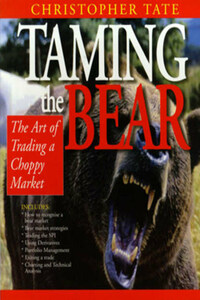Wrightbooks Pty Ltd
PO Box 270
Elsternwick
Victoria 3185
Ph: (03) 9532 7082
Fax: (03) 9532 7084
Email: [email protected]
Web site: www.wrightbooks.com.au
© Christopher Tate 1999
This book is copyright. Apart from any fair dealing for the purpose of private study, research, criticism or review as permitted under the Copyright Act, no part of this publication may be reproduced, stored in a retrieval system, or transmitted in any form or by any means, electronic, mechanical, photocopying, recording or otherwise without prior written permission. Inquiries to be made to Wrightbooks.
National Library of Australia cataloguing-in-publication data:
Tate, Christopher
Taming the bear: the art of trading a choppy market
1. Stock exchanges. 2. Stocks. 3. Investment analysis. 4. Portfolio management
I. Title
Includes index.
ISBN: 1 875857 80 X
332.642
Cover design by Rob Cowpe
The cover image was obtained from IMSI’s MasterClips/MasterPhotos>© Collection
1895 Francisco Blvd. East, San Rafael, CA 94901-5506, USA
The charts in this book were created using SuperCharts
DISCLAIMER
The material in this publication is of the nature of general comment only, and neither purports nor intends to be advice. Readers should not act on the basis of any matter in this publication without considering (and, if appropriate, taking) professional advice with due regard to their own particular circumstances. The author and publisher expressly disclaim all and any liability to any person, whether a purchaser of this publication or not, in respect of anything and of the consequences of anything done or omitted to be done by any such person in reliance, whether whole or partial, upon the whole or any part of the contents of this publication.
IF ASKED TO define a bear market, most investors would say that it is a period of continually declining prices in the entire market. Such an answer would be only partly correct. A bear market may encompass the entire market, but it can also affect a subsection of the market, such as gold stocks (as in 1997), or an individual stock, such as BHP.
Furthermore, a bear market may not actually entail prices falling; prices may just drift sideways in a narrow band for a period of time.
Our definition of a bear market, therefore, is any period when prices are not trending up. This period may be a week, a month or several years. To some extent we are not concerned with time, merely the opportunity to profit from a recognisable period of either price decline or consolidation.
It is important for market participants to realise that the markets are not merely an elevator that goes one way, although this is a view held by many investment advisers, journalists and various “gurus”. Prices spend as much time going down as they do going up, and they spend the bulk of their time drifting in broad consolidation patterns. In fact, it has been estimated that the prices in all markets – be it shares, commodities or currencies – spend as much as 80 % of their time going sideways. Traditionally, such a situation would be extremely frustrating for average market participants, since they would, through a lack of knowledge, be unable to recognise that prices are going sideways. And if they did recognise this, they would lack the techniques to trade and profit from these sideways moves.
“All men can see those tactics whereby I conquer, but what none can see is the strategy out of which victory is evolved.”
SUN TZU, THE ART OF WAR, 6TH CENTURY B.C.
This book hopes to address both of these problems by demonstrating how to recognise bear markets as they emerge and how to trade both the sudden whips down and the broader consolidation patterns that they can represent. If you only have the intellectual or emotional capacity to trade bull markets, you are missing out on a whole range of opportunities offered by the market, and it will be a long time between drinks for you.
Christopher TateMelbourne, January, 1999








